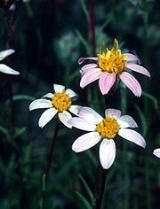
Pentachaeta
Encyclopedia
Pentachaeta is a genus
of the Asteraceae
family; the entire genus is endemic to California
. Of the six species members, at least one, Pentachaeta bellidiflora
, is classified as an endangered species
. The etymology
of the genus name derives from Greek: Penta = five + chaeta
= bristle, referring to the pappus scales of P. aurea
. It was combined in Chaetopappa
, but later work led to the genus being recognized as definitely separate. It is most closely related to Rigiopappus
and Tracyina
.
s are solitary with heads radiate, disciform or discoid; peduncle
s manifest as wispy with bell-shaped involucre
s measuring three to seven millimeters. This genus has green phyllaries in two to three generally equal series, lanceolate to obovate, with margins widely scarious, and a naked receptacle. The white, yellow or red corolla may be simplified to a tube. The disk shaped flowers manifest linear, acute style tips. Fruits are 1.5 to 3.0 millimeters in diameter and are generally compressed in an oblong-fusiform shape and are typically covered with small hairs. Each species presents fragile pappuses with slender slender bristles.
Genus
In biology, a genus is a low-level taxonomic rank used in the biological classification of living and fossil organisms, which is an example of definition by genus and differentia...
of the Asteraceae
Asteraceae
The Asteraceae or Compositae , is an exceedingly large and widespread family of vascular plants. The group has more than 22,750 currently accepted species, spread across 1620 genera and 12 subfamilies...
family; the entire genus is endemic to California
California
California is a state located on the West Coast of the United States. It is by far the most populous U.S. state, and the third-largest by land area...
. Of the six species members, at least one, Pentachaeta bellidiflora
Pentachaeta bellidiflora
Pentachaeta bellidiflora is a Californian wildflower in the genus Pentachaeta of the family. It is included in both the state and federal lists of endangered species....
, is classified as an endangered species
Endangered species
An endangered species is a population of organisms which is at risk of becoming extinct because it is either few in numbers, or threatened by changing environmental or predation parameters...
. The etymology
Etymology
Etymology is the study of the history of words, their origins, and how their form and meaning have changed over time.For languages with a long written history, etymologists make use of texts in these languages and texts about the languages to gather knowledge about how words were used during...
of the genus name derives from Greek: Penta = five + chaeta
Chaeta
A chaeta or cheta is a chitinous bristle or seta found on an insect, arthropod or annelid worms such as the earthworm, although the term is also frequently used to describe similar structures in other invertebrates. The plural form is chaetae or chetae.In the Polychaeta, they are located on the...
= bristle, referring to the pappus scales of P. aurea
Pentachaeta aurea
Pentachaeta aurea is a species of flowering plant in the aster family known by the common names golden-rayed pentachaeta and golden chaetopappa. It is endemic to southern California, where it grows in the San Gabriel and San Bernardino Mountains and the Peninsular Ranges...
. It was combined in Chaetopappa
Chaetopappa
Chaetopappa is a genus of plants in the daisy family which are known generally as leastdaisies. These wildflowers are native to western and central North America...
, but later work led to the genus being recognized as definitely separate. It is most closely related to Rigiopappus
Rigiopappus
Rigiopappus is a monotypic genus whose only species is Rigiopappus leptocladus. It is a flowering plant in the daisy family sometimes known as wireweed. It is an annual plant sending up slender stems terminating in small daisylike yellow flowers. It is native to the western United States. It is...
and Tracyina
Tracyina
Tracyina is a monotypic genus of flowering plants in the daisy family, Asteraceae, containing the single species Tracyina rostrata, which is known by the common name Indian headdress. It is endemic to California, where it is known only from the grassy slopes of the North Coast Ranges north of the...
.
Description
This genus consists of annual plants whose above surface architecture emanates from slender taproot, which appears smooth, but actually is covered by fine hairs. The stems are typically simple or branching in the lower half of plant, and they are erect, generally flexible, and of green to reddish color. Pentachaeta leaves are normally narrowly linear, ciliate and green. The terminal inflorescenceInflorescence
An inflorescence is a group or cluster of flowers arranged on a stem that is composed of a main branch or a complicated arrangement of branches. Strictly, it is the part of the shoot of seed plants where flowers are formed and which is accordingly modified...
s are solitary with heads radiate, disciform or discoid; peduncle
Peduncle (botany)
In botany, a peduncle is a stem supporting an inflorescence, or after fecundation, an infructescence.The peduncle is a stem, usually green and without leaves, though sometimes colored or supporting small leaves...
s manifest as wispy with bell-shaped involucre
Involucre
Involucre may refer to* involucral bract, a bract, bract pair, or whorl of bracts surrounding a flower or inflorescence* a term sometimes misused for the cupule surrounding developing nuts in the Fagaceae...
s measuring three to seven millimeters. This genus has green phyllaries in two to three generally equal series, lanceolate to obovate, with margins widely scarious, and a naked receptacle. The white, yellow or red corolla may be simplified to a tube. The disk shaped flowers manifest linear, acute style tips. Fruits are 1.5 to 3.0 millimeters in diameter and are generally compressed in an oblong-fusiform shape and are typically covered with small hairs. Each species presents fragile pappuses with slender slender bristles.

